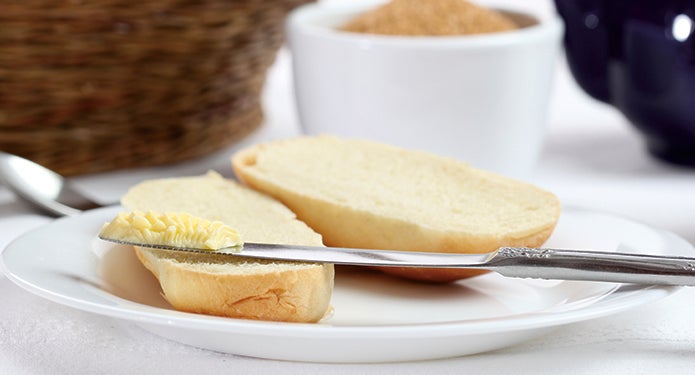The debate over butter versus margarine has been going on for decades. With an evolution in cooking oils and processes, it can be hard to decipher what the best option is for your menu.
Butter
Butter is most commonly made using cow’s milk, but is also made using goat or sheep’s milk. Making butter is an old-fashioned process that has been around for thousands of years and uses one or two simple ingredients: cream and salt.
Pros:
- Butter is made simply from a few ingredients and the product can have a “clean label”* that many consumers are looking for.
- Butter does have high amounts of saturated fats, but the saturated fats in dairy increase both the bad cholesterol (LDL) and good cholesterol (HDL), which may ease the association of increasing one’s risk for heart disease**.
- A derivative of butter – clarified butter – is made through a process of removing the milk fat from butter. This creates a product that has a longer shelf life and is considered lactose free.
- Clarified butter has a higher smoke point than butter because the milk solids are removed, which burn at lower temperatures. This makes clarified butter ideal in certain cooking applications, such as high heat cooking.
- Butter has a great flavor and texture profile for cooking and baking that can be hard to replace in many recipes.
Cons:
- Because butter is made from animal products, it is higher in saturated fat and cholesterol compared to margarine.
- If you are buying clarified butter, it will be more expensive compared to purchasing butter or margarine. If you choose to make clarified butter, there will be additional labour involved and some product loss.
- Clarified butter is still high in calories and fat so it should be used sparingly.
- Butter also has small amounts of naturally-occurring trans fats per serving; though these naturally-occurring trans fats in dairy are not considered harmful and have not been associated with heart disease.
- One tablespoon of butter contains 100 calories and can lead to weight gain quite quickly.
Margarine
Margarine is a butter substitute formulated from vegetable oils and water. Across its history, margarine has been marketed as a healthier alternative because of its saturated fats content. There are a variety of formulations of margarine in the marketplace including versions that are positioned as low-fat, salt-free, and lactose-free that are made from a variety of vegetable oils.
Pros:
Margarine is lower in saturated fat than butter because it is made from vegetable oil instead of animal products.
Margarine is naturally cholesterol free and contains higher levels of monounsaturated and polyunsaturated fats (good fats). Unsaturated fats help to lower bad cholesterol in the body.
Cons:
- Margarine can contain trans fat or partially hydrogenated oils. Research has shown this type of fat is worse than saturated fat because they greatly increase your risk of cardiovascular disease.
- Tip: Always read the ingredient label for margarine. Labeling laws allow manufacturers to say trans fat is 0 grams per serving if the serving contains less than .2 grams.
- The words “partially hydrogenated” identifies that product could contain some trans-fat. Depending on the formulation, tub margarine or soft margarine will be lower in trans fat compared to stick margarine or hard margarine.
- Like butter, margarine is high in calories and should be used in small amounts.
Deciding What’s Best for Your Menu
There is no definitive answer whether butter or margarine is the better option, but most dietary experts agree when it comes to cooking to use a liquid oil in place of butter, margarine or clarified butter.
But there will always be certain foods where that delicious and rich butter flavor is wanted. Simply remember to use them judiciously, as both butter and margarine contains 100 percent fat and consuming them frequently can quickly increase the total calories in the diet.
In the end, whether you are choosing butter or margarine; it is important to always read labels to understand what is in the food you are buying, serving, and consuming.
*A clean label is one that has few ingredients, and the ingredients are free of artificial sweeteners, added preservatives and food additives.
**Cholesterol 101: Good vs. Bad. Low-density lipoprotein (LDL) is known as the bad cholesterol. This is because it plays a role in plaque build up within arteries. If plaque build up is left untreated and becomes severe it can lead to a heart attack or stroke. High-density lipoprotein (HDL) is known as the good cholesterol. It helps remove LDL from the arteries.For more information about cholesterol, LDL or HDL visit www.heart.org.










